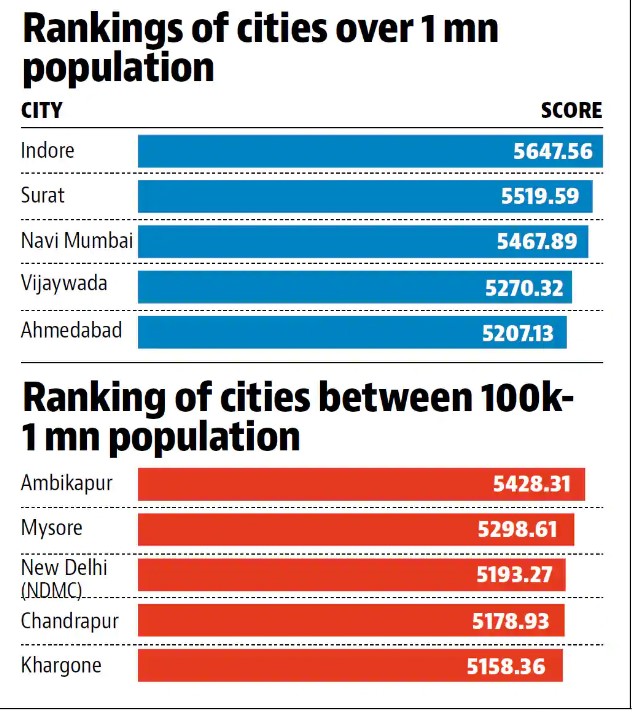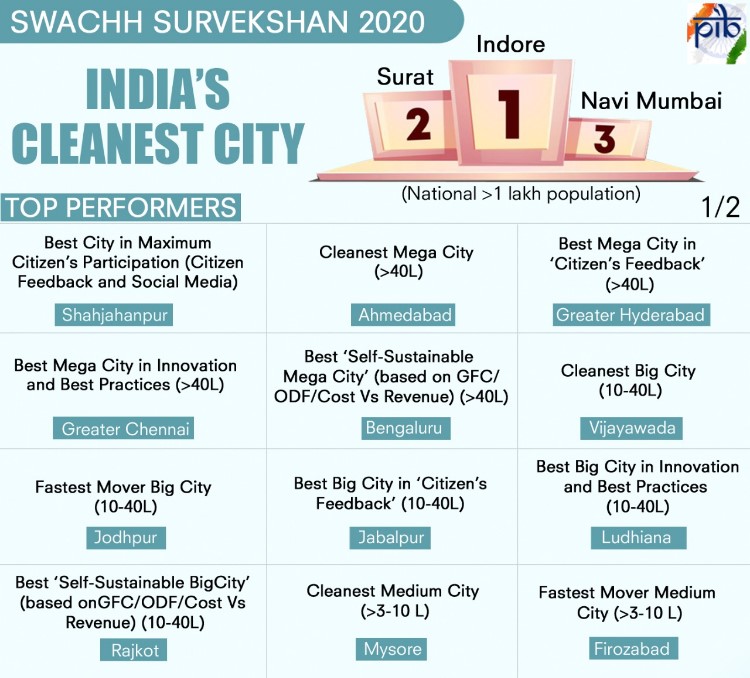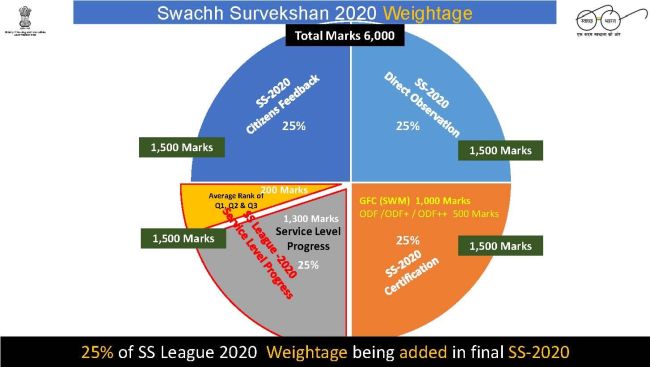Contents
- Swachh Survekshan 2020
- PMEGP Projects Records 44% Implementation Jump
- AIM and India-Sweden Healthcare Innovation Centre
SWACHH SURVEKSHAN 2020
Focus: GS-III Environment and Ecology, GS-II Governance
Why in news?
Minister of State (Independent Charge) for Housing and Urban Affairs gave away the awards for Swachh Survekshan 2020, the fifth edition of the annual cleanliness urban survey conducted.
Highlights
Cleanest city awards for cities with population above 1 lakh –
- Indore (Madhya Pradesh)
- Surat (Gujarat)
- Navi Mumbai (Maharashtra)
Cleanest city awards for cities with population below 1 lakh –
- Karad (Maharashtra)
- Saswad (Maharashtra)
- Lonavla (Maharashtra)
- Cleanest state with more than 100 cities – Chhattisgarh
- Cleanest state with less than 100 cities – Jharkhand
- Cleanest Ganga town – Varanasi (Uttar Pradesh)
- Maximum citizen participation in keeping city areas clean – Shahjahanpur
- Cleanest megacity with more than 40 lac population – Ahmedabad (Gujarat)
Best self-sustainable cities with population above 40 lakh-
- Bengaluru (Karnataka)
- Vijayawada (Andhra Pradesh)
Fastest-moving city in terms of cleanliness – Jodhpur (Rajasthan)
Self-sustainable city in terms of cleanliness (more than 10 lakh population) – Rajkot (Gujarat)
Self-sustainable city in terms of cleanliness (less than 10 lakh population) – Mysuru (Karnataka)
Cleanest small cities –
- Ambikapur (Chattisgarh)
- Burhanpur (Madhya Pradesh)
- Cleanest city with population between 1 lakh to 3 lakh – Tirupati (Andhra Pradesh)
- Cleanest capital city – New Delhi (Union Territory of New Delhi) and the NDMC.


Swachh Survekshan
- Swachh Survekshan was launched by PM Modi in 2016 – meant to monitor the performance of Swachh Bharat Abhiyan, which was launched on October 2, 2014, the 150th birth anniversary of Mahatma Gandhi.
- The extensive sanitation survey is commissioned by the Ministry of Urban Development and carried out annually by Quality Council of India.
- The survey was introduced by the government with the objective of generating large-scale participation in Swachh Bharat Abhiyan.
- It was also aimed at inculcating a spirit of healthy competition among cities towards becoming India’s cleanest cities.
Assessment
- Swachh Survekshan 2020 is evaluated for each quarter on the basis of monthly updation of Swachh Bharat Mission-Urban (SBM-U) online Management Information System (MIS) by cities along with citizen’s validation on the 12 service level progress indicators.
- These quarterly assessments will hold 25% weightage in the annual survey.
Ranks for Swachh Survekshan 2020 have been assigned based on the population in two categories of the cities:
- 1 lakh and above with sub-categories of
- 1-10 lakh
- 10 lakhs and above.
- Less than 1 lakh (under this category, the rankings are given zone and population-wise).
- It includes five zones namely, North, East, Northeast, South and West.

Significant results
- Mysuru was chosen as the cleanest city in India in the first edition of the survey.
- Fourth edition of the survey in 2019 was the first-of-its-kind completely digital survey completed in a record time of 28 days.
- Indore (Madhya Pradesh) and Jamshedpur (Jharkhand) have topped the cleanliness charts for two consecutive quarters among cities with over 10 lakh population and with 1 lakh to 10 lakh population respectively.
- Kolkata ranked at the bottom of the ranking of 49 major cities across both quarters as West Bengal did not participate in the nationwide exercise.
PMEGP PROJECTS RECORDS 44% IMPLEMENTATION JUMP
Focus: GS-III Indian Economy
Why in news?
- The flagship Prime Minister Employment Generation Program (PMEGP) implemented by Khadi and Village Industries Commission (KVIC) progressed at a much rapid pace even as the country’s economy took a severe jolt due to Covid-19 lockdown.
- The Ministry of MSME introduced a new and faster mechanism in approving the PMEGP projects, the approval of projects during the first five months of this financial year 2020, increased by a whopping 44%.
Details
- Khadi and Village Industries Commission (KVIC), has approved and forwarded more than 1 lakh project applications to the financing banks – registering a jump of 44%.
- KVIC, the nodal agency for implementing PMEGP scheme, was entrusted the task of clearing the applications from prospective entrepreneurs and forward it to the Banks for taking credit decisions.
- The faster implementation of PMEGP projects this year assumes greater significance as the entire country was under lockdown for a significant portion of the year.
Prime Minister Employment Generation Program (PMEGP)
- The Prime Minister’s Employment Generation Programme (PMEGP) the result of the merger of two schemes – Prime Minister’s Rojgar Yojana (PMRY) and The Rural Employment Generation Programme (REGP).
- PMEGP is a credit-linked subsidy scheme which promotes self-employment through setting up of micro-enterprises, where subsidy up to 35% is provided by the Government through Ministry of MSME for loans up to ₹25 lakhs in manufacturing and ₹10 lakhs in the service sector.
- PMEGP was established for generation of employment opportunities through establishment of micro enterprises in rural as well as urban areas.
- PMEGP is a central sector scheme administered by the Ministry of Micro, Small and Medium Enterprises (MoMSME).
- At the national level, the Scheme is being implemented by Khadi and Village Industries Commission (KVIC), a statutory organization under the administrative control of the Ministry of MSME as the single nodal agency.
- At the State level, the Scheme will be implemented through State KVIC Directorates, State Khadi and Village Industries Boards (KVIBs) and District Industries Centres (DICs) and banks.
Objectives of PMEGP
- To generate continuous and sustainable employment opportunities in Rural and Urban areas of the country
- To provide continuous and sustainable employment to a large segment of traditional and prospective artisans, rural and urban unemployed youth in the country through setting up of micro enterprises.
- To facilitate participation of financial institutions for higher credit flow to micro sector.
Eligibility to avail this scheme:
- Individuals above 18 years of age
- VIII Std. pass required for project above Rs.10.00 lakhs in manufacturing and above Rs. 5.00 lakhs for Service Sector
- Self Help Groups and Charitable Trusts
- Institutions Registered under Societies Registration Act- 1860
- Production based Co-operative Societies
AIM AND INDIA-SWEDEN HEALTHCARE INNOVATION CENTRE
Focus: GS-II International Relations
Why in news?
In line with a shared vision of expanding the culture of innovation in the country, Atal Innovation Mission (AIM), NITI Aayog and Business Sweden on behalf of India Sweden Healthcare Innovation Centre are collaborating to promote the disruptive potential of Indian entrepreneurs, and, boost the vibrant start-up ecosystem across the country.
Highlights
- Under AIM, various programmes or initiatives are being run such as Atal New India Challenge (ANIC), Atal Incubation Centre (AIC), Atal Community Innovation Centers (ACIC), Atal Tinkering Lab (ATL) and Atal Research & Innovation for Small Enterprises (ARISE).
- Through this collaboration, these initiatives are set to receive support by the means of conducting programs, awareness campaigns, various activities and events that would promote the overall innovation grid of both the countries through these programmes.
- Through this collaboration with Atal Innovation Mission, the India-Sweden Healthcare Innovation centre ecosystem will be further strengthened to provide all the required support to the innovators for faster scale-up of their solutions.
India-Sweden Healthcare Innovation Centre
- India-Sweden Healthcare Innovation Centre is a collaboration between AIIMS Delhi, AIIMS Jodhpur and Business Sweden.
- The Innovation Centre aims to create an ecosystem of open innovation and is built under strategic guidance from Government of India’s Ministry of Health and Family Welfare, Indian Council of Medical Research (ICMR), Government of Sweden’s Ministry of Health and Social Affairs and Embassy of Sweden in India.
- It also has a strong network of ecosystem partners.
- The Innovation centre has recently launched its first healthcare innovation challenge to collaborate with partners on the Innovation Centre platform to help solve some of the problems in the healthcare delivery landscape of India.
Atal Innovation Mission (AIM)
- Atal Innovation Mission (AIM) is NITI Aayog’s flagship initiative to promote a culture of innovation and entrepreneurship in India
- AIM has been established to create and promote an ecosystem of innovation and entrepreneurship in a holistic manner through various initiatives at school, university and industry levels
The Atal Innovation Mission has thus two core functions:
- Innovation promotion: to provide a platform where innovative ideas are generated.
- Entrepreneurship promotion: Wherein innovators would be supported and mentored to become successful entrepreneurs at Incubation Centres.





